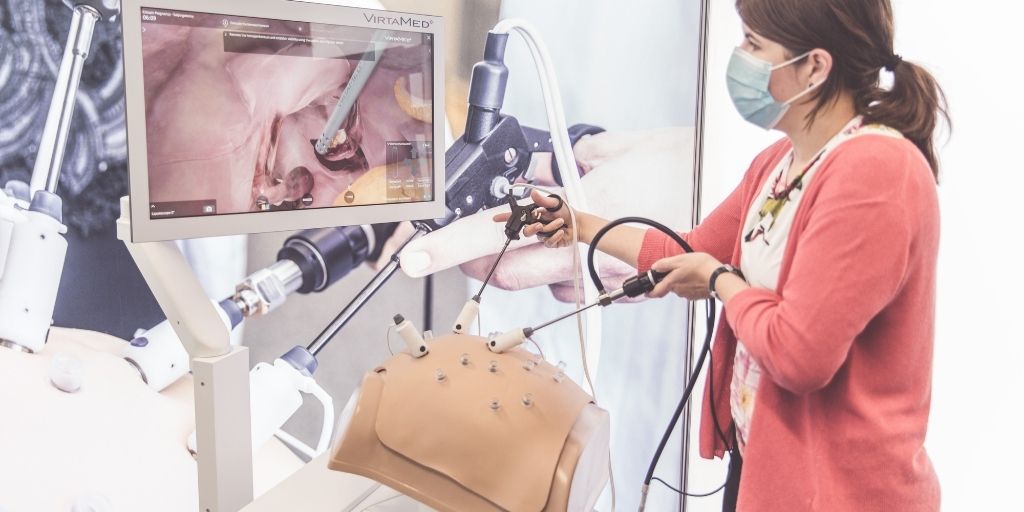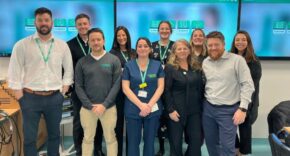
Award-winning gynaecology and laparoscopy simulation suites from VirtaMed given a unique positioning feature for precise, realistic training
Medical education has been hugely affected by the COVID-19 pandemic, however, it hasn’t stopped, simply adapted further and utilised the technologies that are available today. The need to learn surgical skills outside the clinical environment has never been greater. While the COVID-19 pandemic has reduced medical training opportunities in the traditional apprenticeship method, with fewer elective procedures and reduced access for residents to operating rooms, surgical simulation technology has seen rapid growth and development. Over the past few years, it is no surprise that simulation has been at the forefront of training for surgical procedures most often taught in an operating theatre environment.
Simulation training has been able to continue throughout the pandemic, and forecasts predict that there will be a further shift towards virtual and mixed reality simulators. Findings of a recent study into Cadaver V Simulation training strengthens the evidence base for medical establishments to rapidly transition to digital training solutions and furthermore strengthens the outlook for simulation training in a post-COVID future.
VirtaMed has been a leader in the growing use of surgical simulators and its mobile simulation labs have been touring Europe throughout the pandemic, providing socially distanced training in a clean and safe environment. In addition, the company has further developed its suite of simulators to offer a more advanced range of dynamic training. In particular, it has launched its upgraded surgical gynaecology simulation suite which enables gynaecologists to benefit from a combined mixed reality training platform for hysteroscopy and gynaecological laparoscopy.
VirtaMed has already developed the world-leading simulator for hysteroscopy training, with peer-reviewed papers validating their approach to simulation dating back to 2009. Its hysteroscopy simulator is used worldwide by teaching institutions and medical societies, plus specific medical devices and procedures continue to be integrated into the system.
This year, VirtaMed’s hysteroscopy training modules have been updated to include 16 cases for MyoSure® tissue removal, added to over 50 cases in diagnostics, polypectomy, myomectomy, tissue ablation and advanced electrosurgical resection. All cases include competency-based objective feedback and a variety of pathologies with increasing procedural difficulty, including complication handling.
A unique approach to simulation
Until now, gynaecologists have often inherited laparoscopic teaching equipment from general surgeons. 2020 was the first year that obstetrics and gynaecology residents in the United States were required to pass the Fundamentals of Laparoscopic Surgery, a curriculum developed by general surgeons in 1997. This is a wonderfully positive step forward in the objective assessment of surgical skills, however, it is yet to leverage the advanced technology that is being developed for gynaecological medical education today.
Extrapolating from the success of VirtaMed’s hysteroscopy simulator, the company developed a laparoscopic simulator with several key elements in mind to optimally transfer skills from the training environment to the clinical setting.
Firstly, surgical instruments must feel the same in the surgeon’s hand as they do in the operating room. This means the surgeon must be able to position the patient ready for the procedure (classically in the Trendelenburg position), stand in the correct place relative to the patient, pick up an instrument, and insert it into a patient model. The principal is that acquiring and improving psychomotor skills relies, in part, on the authentic and consistent tactile sensation.
A corollary to this is the need for accurate tissue feedback, which means simulating each organ with its own distinct physical properties, such as density, and mechanical properties, such as elasticity. VirtaMed’s unique approach introduces active trocars, which can be freely placed across the abdomen and provide tissue feedback for each specific organ during a simulated intervention.
Secondly, a motivational teaching program should use short training sequences, followed by objective formative feedback. Therefore, VirtaMed has used task decomposition to identify key skills and create focused, high-intensity training cases that allow the learner to repeat a specific skill until proficiency is reached. Then the learner can combine these skills to perform a full procedure, again benefiting from objective formative feedback that directs them to improve specific skills again.
Thirdly, trainees should encounter unexpected scenarios as a form of proximal learning. These may be anatomical variations in the patient case or adverse events that could be encountered during a procedure. Here the key is to present the trainee with a complex scenario and give them the opportunity to resolve it in their own time. This is a game-changer from the operating room, where often a senior surgeon will step in if a complication is encountered, and also from cadaver training where it is not possible to restart complications on-demand and ad infinitum.
VirtaMed’s new and upgraded suite of simulators are responding to the global training need and are offering unique training aspects which will greatly benefit trainees. For the first time, this gives the trainee a simulation set up that reflects what they will encounter in the operating room, rather than inheriting positions derived from general surgery training. Students can now practice key clinical skills in the most realistic and motivational simulation environment.
This revolutionary simulator, the VirtaMed LaparoS™, includes an anatomically correct abdomen model that can be used for (reverse) Trendelenburg positioning as appropriate to the training case. Free choice of portals enables trainees to learn instrument handling with different trocar placement. Realistic laparoscopic instruments have been adapted for simulation and combine full freedom of movement with authentic haptic interactions. The surgical simulator is optimized for ergonomic training with an adjustable operative height and a movable multi-touch screen.
A versatile, futureproof simulation platform to meet all training needs.
Importantly, with the new upgraded VirtaMed Surgical Simulator multidisciplinary platform, a multidisciplinary simulation centre can now provide endoscopic training in orthopaedics, gynaecology, urology and general surgery on the same platform — which really increases ROI for surgical simulation programs which are educating and training across multiple specialities.
VirtaMed’s simulators also help training institutions fulfil their commitments to sustainability. Simulators can be used over and over, reducing the overhead of equipping wet labs and the costs of disposables and instrumentation. Many countries have taken the necessary step to stop cadaver training due to the Covid risk, adding to the countries that already ban cadaver or animal training.
Dr. Martina Vitz, former Director of the LapCenter in Zurich, Switzerland, said, “I had several surgeons that would come to me for simulation training each year because I was the only vegan training possibility that they had.”
Simulation training is the future of surgical training and has been demonstrated to shorten the learning pathway while offering enhanced proficiency and procedure confidence for both young trainees and experienced surgeons. VirtaMed’s continuous advancement of its simulators and innovative training methods both during and after the pandemic will ensure our future surgeons are confident and prepared to tackle all operating theatre procedures.
To find out more about VirtaMed’s simulators visit www.virtamed.com/surgical-gynecology
Author Phil Norris, VirtaMed











